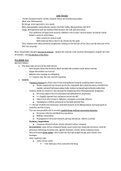1000-750 BCE
- World remained empty: mostly isolated tribes and wandering peoples
- Ideal was still harmony
- But kings were expected to win spoils
- Main demographic and political centres: the Nile Valley, Mesopotamia, IGP, NCP
- Egypt, Mesopotamia and the Eastern Med became one vast political arena
- The ambitions of Egypt and Assyria collided in the Levant. Several lesser Levantine states
failed to unite to resist them.
- Both wanted to control trade
- Both believed their rulers to be chosen by the gods
- Zhou clashes with their powerful neighbours, leading to the decline of the Zhou and the descent of the
NCP into anarchy.
Most remarkable changes: the rise of Assyria - shaped the outlook of the Eastern Hemisphere, shaped the west
of Eurasia - and the decline of the Zhou.
The Middle East
MESOPOTAMIA
● The Dark Ages all across the Med shores
○ Sea-Peoples (from the Northern Med) invaded the southern and eastern shores.
○ Egypt descended into turmoil
○ Babylon was verging on collapsing
○ ==> Assyria was the only one left standing
● Assyria
○ Domestic reforms by Ashur-dan II that strengthened Assyria, enabling later victories
■ Realm organised into formal provinces, regulated their administration, fortified the
capital, restored fortresses along trade routes, increased agricultural production.
○ Assyria seized its chance to rise among the despairing other Mesopotamian kingdoms.
■ 910: King Adad-nirari II confronted and defeated the Arameans.
■ ==> Rapidly spread their influence across the ME
■ Adad-nirari sent troops to Babylon, arranged a marriage alliance.
■ Campaigns in Hittite; advanced to the Med and Red Sea
○ ==> By late C9 (800), the Assyrians controlled almost all of Mesopotamia and large parts of
Anatolia and the Levant.
○ The rise was possible due to several capable kings without succession disputes.
■ Economic reforms satisfied the population
■ Military innovation
■ Propaganda to terrorise enemies, giving ultimatum: tribute or perish
○ Predatory imperialism
■ Conquest allowed tribute, which allowed further conquest
○ Incorporation: some of the conquered lands were turned into imperial provinces, ruled by
governors following Assyrian law, spread Assyrian culture, levied Assyrian taxes.
○ Others became client states: ruled indirectly through puppet kings, paid tribute, sent
hostages.
○ Clear imperial order
■ Ashur at the centre
● = the chief god, who instructed the king
, ■ The palace, surrounded by the city, surrounded by farmland = ‘the middle kingdom’,
the land chosen by the gods.
■ The lands beyond were the ‘failed cosmos’, abandoned by the gods.
○ Benefited from the weakness of its neighbors:
■ Slow recovery from the Bronze Age Collapse
■ Quarreling amongst themselves
■ Ex. Libyan Dynasty (Egypt)
● Shosehnq’s death led to succession conflicts, only stopped by Osorkon’s
ascendancy. But after Osorkon’s death: dynastic struggle, Egypt split in two.
○ Only around 710, a Nubian pharaoh would reunify it.
○ Imperial ideology/order
■ The king was the representative if the god Ashur
● Wherever he reigned, there’d be peace, justice.
THE LEVANT
● Patchwork of small cities and kingdoms: Aram, Israel, Ammon, Judah, Edom, Moab
● Attractive target (for the Libyans): politically weak but wealthy from trade
○ Trade routes: the King’s Highway, the Way of the Sea.
○ Tyre
■ (like C12 Venice to Italy)
■ The Phoenicians of Tyre wove the entire Mediterranean into a web of commerce
centred on their city.
■ Possessed colonies (even in Strait of Gibraltar)
● Perpetual struggle between kingdoms (-> Old Testament)
○ Israel as hegemon under King Saul
■ Successors David and Solomon enlarged the kingdom
■ Gained control over the Way of the Sea and King’s Highway
■ Trade agreement with Tyre
■ But split after Solomon’s death; southern part became Judah.
○ Alliance between Egypt (Libyans) and Israel. Egypt brought into the region by Israel; besieged
Judah.
○ Judah bribed Aram to end treaty with Israel and open a second front
○ Moab and Ammon invaded Judah, joined by Aram. Judah was forced to sue for peace.
● 853: whole of the Levant was threatened by potential invasion of Assyria
○ Mutual conflicts ended to form a formidable alliance: Babylon, Egypt, Aram, Persia, Israel, +
10
■ BUT Assyria won. Forced most into vassalage
● Return to infighting
○ Aram vs Israel’; Alliance Israel-Judah against Aram, sealed with a marriage alliance. (849)
○ Aram was invaded by Assyria (815)
○ Alliance Aram-Babylonia-Eram to ward off further Assyrian invasions
● Old Testament: recounts the relentless fighting, shifting alliances, and permanent threat of great
powers like Assyria.
● Thinking about governance
○ Old Testament
■ Israel as the nation chosen by God.
■ The ideal was a society of disparate tribes united as a common front against
external enemies.





